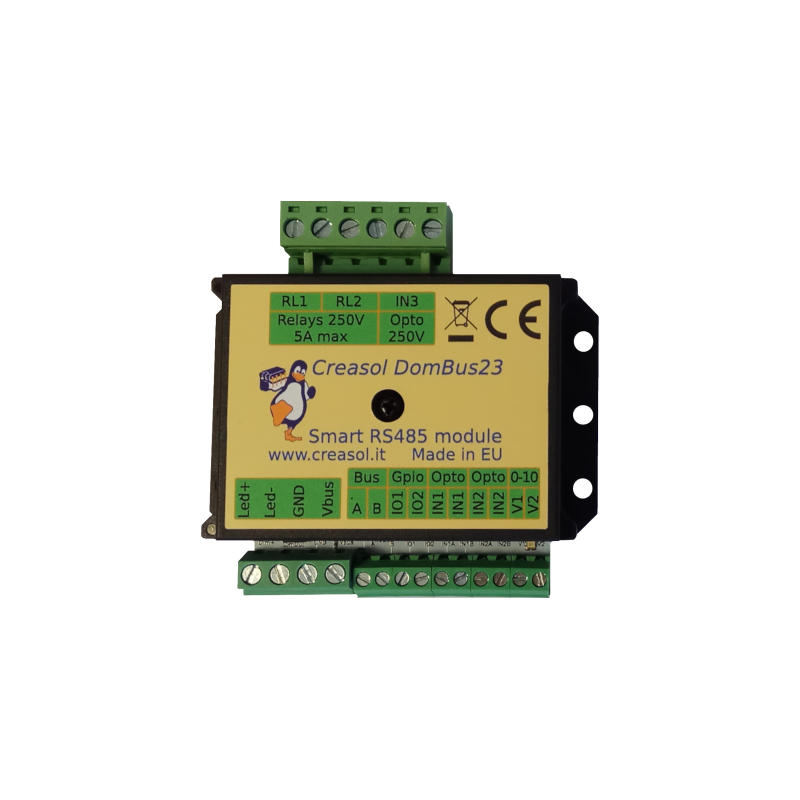

Email: store@creasol.it - Telegram: CreasolTech - Whatsapp: +393283730010
Prioritetinis paštas: greitas ir pigus - Greitasis kurj
Prieš grąžindami prekes susisiekite su mumis!

„Creasol DomBus23“ yra modulisnamų automatikos sistemaisu keliais skirtingais įėjimais / išėjimaistrumpo dydžio: 74x72x24mm. p>
Jį prie „Domoticz“ valdiklio galima prijungti RS485 nuosekliąja magistrale (4 laidai, 2 - 12 / 24V maitinimo šaltiniui ir 2 - duomenims esant 115200bps).
Kaip ir kiti „DomBus“ įrenginiai,„DomBus23“ sukurtas taip, kad sunaudotų mažai energijos, būtų patikimas, visiškai sukonfigūruojamas ir lengvai naudojamas.
 Visiškas palaikymas: daugumą produktų sukūrėme mes!
Visiškas palaikymas: daugumą produktų sukūrėme mes!
Email: store@creasol.it - Telegram: CreasolTech - Whatsapp: +393283730010
 Užsakymai išsiunčiami per 1 darbo dieną
Užsakymai išsiunčiami per 1 darbo dieną
Prioritetinis paštas: greitas ir pigus - Greitasis kurj
 24 mėnesių garantija, lengvas grąžinimas / grąžinimas
24 mėnesių garantija, lengvas grąžinimas / grąžinimas
Prieš grąžindami prekes susisiekite su mumis!
„Creasol DomBus23“ yra modulisnamų automatikos sistemaisu keliais skirtingais įėjimais / išėjimaistrumpo dydžio: 74x72x24mm. p>
Jį prie namų automatikos valdiklio galima prijungti RS485 nuosekliąja magistrale (4 laidai, 2 - 12 / 24V maitinimo šaltiniui ir 2 - duomenims esant 115200bps).
Palaikomi namų automatikos sistemos valdikliai yraDomoticz.
Kaip ir kiti „DomBus“ įrenginiai,„DomBus23“ sukurtas taip, kad sunaudotų mažai energijos, būtų patikimas, visiškai sukonfigūruojamas ir lengvai naudojamas.

p>
stiprus>
Daugiau informacijos 23. https://www.creasol.it/CreasolDomBus
Numatytasis adresas: 0xff23
| Uosto Nr. | vardas | Galimybės | Numatytoji konfigūracija | apibūdinimas |
| 1 | RL1 | OUT_DIGITAL, OUT_RELAY_LP, OUT_BLIND | OUT_RELAY_LP | SPST relės išvestis su 250Vac 5A kontakto sparta arba 30Vdc 5A kontakto sparta. Relės kontaktą nuo viršįtampio apsaugo varistorius |
| 2 | RL2 | OUT_DIGITAL, OUT_RELAY_LP, OUT_BLIND | OUT_RELAY_LP | SPST relės išvestis su 250Vac 5A kontakto sparta arba 30Vdc 5A kontakto sparta. Relės kontaktą nuo viršįtampio apsaugo varistorius |
| 3 | MOS | OUT_DIGITAL, OUT_DIMMER | OUT_DIMMER | „Mosfet“ atviro nutekėjimo išėjimas, 30 V 12 A maks., Tinkamas valdyti šviesos diodų juosteles (su galimybe reguliuoti ryškumą naudojant „DomBus“ pritemdymo funkciją, 0–100% su 5% pakopa) ar kitas nuolatinės srovės apkrovas. |
| 4 | V1 / OD1 | OUT_ANALOG, OUT_DIGITAL, OUT_RELAY_LP, OUT_BLIND | OUT_ANALOG |
Analoginė išvestis, 0-10 V, tinkama valdyti kitos elektroninės plokštės (dimerio, šilumos siurblio, linijinio vožtuvo ir kt.) 0-10 V arba 1-10 V įvestį. |
| 5 | V2 / OD2 | OUT_ANALOG, OUT_DIGITAL, OUT_RELAY_LP, OUT_BLIND(1) | OUT_ANALOG | OAnalog išvestis, 0-10V, tinkama valdyti kitos elektroninės plokštės (dimerio, šilumos siurblio, linijinio vožtuvo ir kt.) 0-10V arba 1-10V įvestį. Pasirinktinai galima konfigūruoti šį prievadą kaip atviro nutekėjimo išėjimą 40 V 100 mA, maks., Kurį galima prijungti prie išorinių šviesos diodų ar relės naudojant papildomą 5 laidų kabelį:od2Šiuo atveju reikia sutrumpinti pcb megztinį. |
| 6 | IO1 | IN_DIGITAL,IN_ANALOG, IN_TWINBUTTON, IN_COUNTER, OUT_DIGITAL, OUT_BLIND, OUT_DIMMER, OUT_BUZZER | IN_DIGITAL |
Analoginis / skaitmeninis įėjimas, kuris gali būti naudojamas įtampai nuskaityti, arba gali būti prijungtas prie kontakto, jungiklio, magnetinio jutiklio, PIR, ... |
| 7 | IO2 | IN_DIGITAL, IN_ANALOG, IN_TWINBUTTON, IN_COUNTER, OUT_DIGITAL, OUT_BLIND(1), OUT_DIMMER, OUT_BUZZER | IN_DIGITAL | Analoginis / skaitmeninis įėjimas, kuris gali būti naudojamas įtampai nuskaityti, arba gali būti prijungtas prie kontakto, jungiklio, magnetinio jutiklio, PIR, ... Jis gali būti sukonfigūruotas kaip skaitiklis ir prijungtas prie energijos / dujų / vandens skaitiklio. Jį galima sukonfigūruoti kaip IN_TWINBUTTON (kurį galima prijungti prie dvigubo mygtuko), sutrumpinant PCB jungiklįRU2arba 10mA IŠĖJIMAS sutrumpindamas PCB trumpiklįRO2: pastaruoju atveju jis gali būti naudojamas kaip silpnos srovės 3 V išėjimas, prijungtas prie garsinio signalo arba prie relės plokštės ritės tvarkyklėje. |
| 8 | IN1 | IN_AC | IN_AC, IN_COUNTER | Žemos įtampos įėjimas, 9–40 V kintamosios arba nuolatinės srovės, opto izoliuotas. Tinka nujausti, ar yraĮtampa |
| 9 | IN2 | IN_AC | IN_AC, IN_COUNTER | Žemos įtampos įėjimas, 9–40 V kintamosios arba nuolatinės srovės, opto izoliuotas. Tinka suvokti įtampą |
| 10 | IN3 | IN_AC | IN_AC, IN_COUNTER | 230 V įėjimas, izoliuotas. Tinka nustatyti įtampą ir nustatyti elektros energijos tiekimo nutraukimą |
(1): gali būti naudojamas kaip BLIND išėjimas, norint atidaryti žaliuzę / užuolaidą, tačiau tik ankstesnį prievadą galima sukonfigūruoti „Domoticz“ kaip OUT_BLIND, nes, sukonfigūruotas kaip OUT_BLIND, „DomBus“ įrenginys automatiškai sukonfigūruoja kitą prievadą, kad valdytų relę atidarytoje vietoje kryptis.
„DomBus23“ modulis gali būti sąsaja su „Domoticz“ ir, naudodamas vidinį „MOSFET“ su 30 V 12 A, gali viduje reguliuoti LED juostos ryškumą.
Be to, „DomBus23“ turi 2 analoginius išėjimus 0–10 V, leidžiančius valdyti 2 papildomas LED juostas išoriniu šviesos reguliatoriumi.
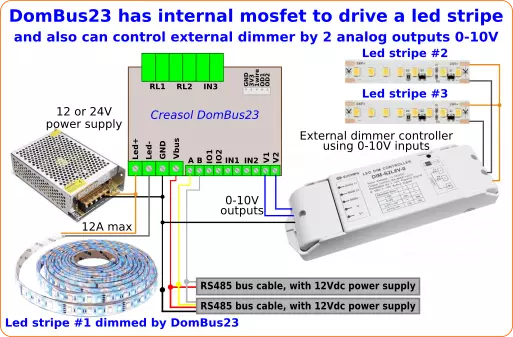
Ši schema parodo, kaip prijungti vartų atidarymą ar garažo vartų atidarymą prie „DomBus23“ modulio, leidžiančio namų automatikos sistema valdyti vartus ir garažo vartus („Domoticz“, ...)
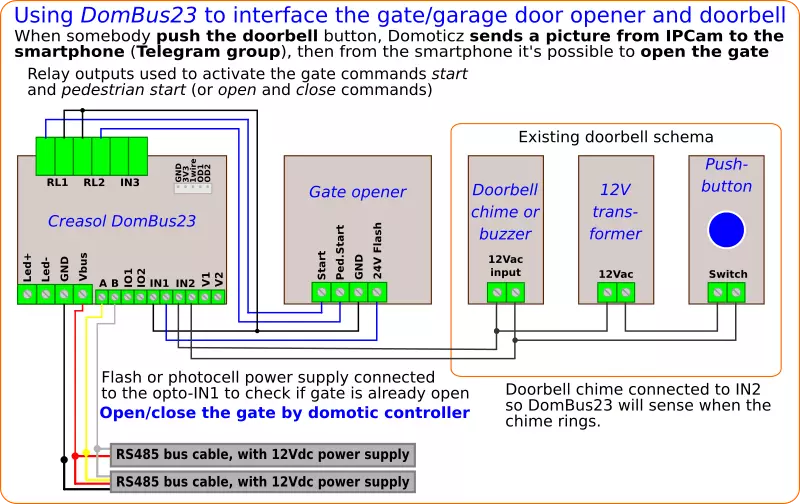
Daugiau informacijos 23. https://www.creasol.it/CreasolDomBus
The following video shows a presentation of some domotic modules designed and produced in Italy by Creasol to make a reliable, easy and power-optimized home automation system.
The next video shows our Smart EVSE module that can be used to charge the electric car by using only solar power, or adding 25/50/75/100% of available power from the electrical grid.
Our industrial and home automation modules are designed to be
Modules are available in two version:
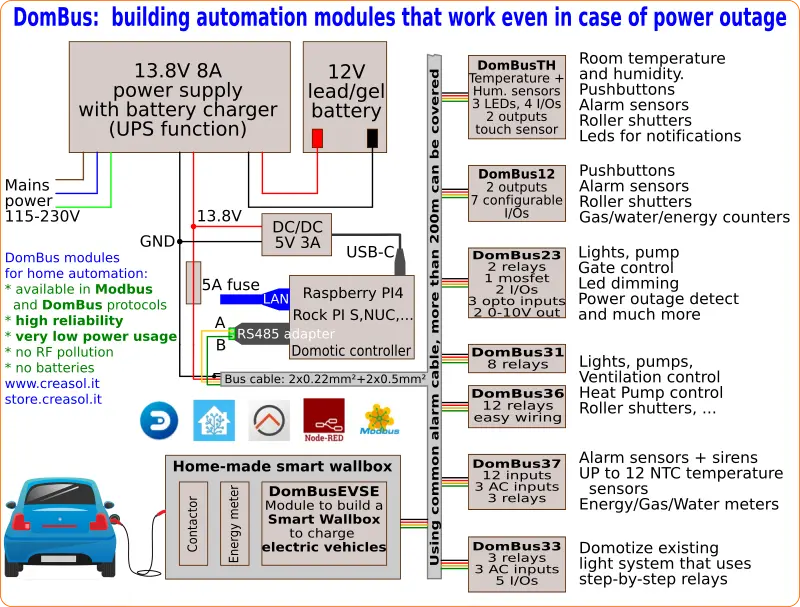
Store website - Information website
For our products we can offer FULL SUPPORT and CUSTOMIZATION: please contact us by Email or Telegram
 Complete solution to make a Smart EVSE, charging the electric vehicle using only energy from renewable source (photovoltaic, wind, ...), or adding 25-50-75-100% of available power from the grid.
Complete solution to make a Smart EVSE, charging the electric vehicle using only energy from renewable source (photovoltaic, wind, ...), or adding 25-50-75-100% of available power from the grid.
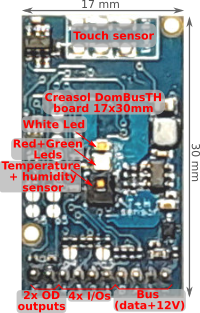 Compact board, 32x17mm, to be installed on blank cover with a 4mm hole in the middle, to exchange air for the relative humidity sensor. It can be installed in every room to monitor temperature and humidity, check alarm sensors, control blind motor UP/DOWN, send notifications (using red and green leds) and activate white led in case of power outage.
Compact board, 32x17mm, to be installed on blank cover with a 4mm hole in the middle, to exchange air for the relative humidity sensor. It can be installed in every room to monitor temperature and humidity, check alarm sensors, control blind motor UP/DOWN, send notifications (using red and green leds) and activate white led in case of power outage.
Includes:
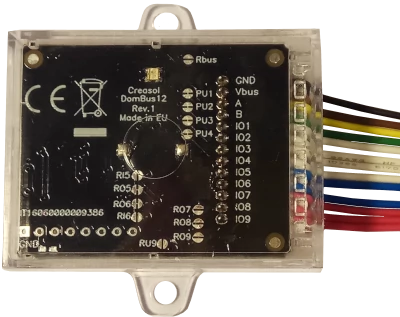 Very compact, versatile and cost-effective module with 9 ports. Each port can be configured by software as:
Very compact, versatile and cost-effective module with 9 ports. Each port can be configured by software as:
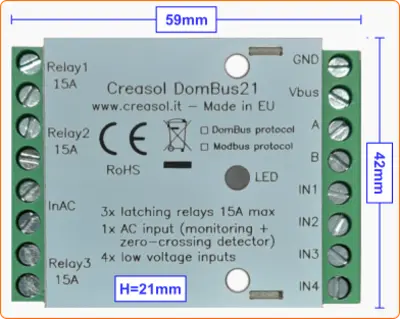 Very low power consumption module designed to enable up to 3 high power loads, up to 15A (3kW).
Very low power consumption module designed to enable up to 3 high power loads, up to 15A (3kW).
 Versatile module designed to control gate or garage door.
Versatile module designed to control gate or garage door.
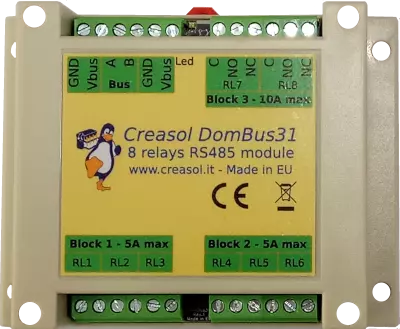 DIN rail low profile module, with 8 relays and very low power consumption:
DIN rail low profile module, with 8 relays and very low power consumption:
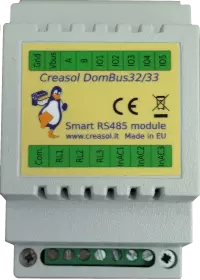 Versatile module with 230V inputs and outputs, and 5 low voltage I/Os.
Versatile module with 230V inputs and outputs, and 5 low voltage I/Os.
 Module designed to control 3 lights already existing and actually controlled by 230V pushbuttons and step-by-step relays. In this way each light can be activated by existing pushbuttons, and by the domotic controller.
Module designed to control 3 lights already existing and actually controlled by 230V pushbuttons and step-by-step relays. In this way each light can be activated by existing pushbuttons, and by the domotic controller.
Each relay can toggle the existing step-relay, switching the light On/Off. The optoisolator monitors the light status. The 5 I/Os can be connected to pushbuttons to activate or deactivate one or all lights.
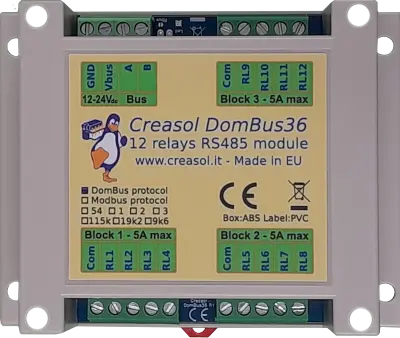 DIN rail module, low profile, with 12 relays outputs and very low power consumption.
DIN rail module, low profile, with 12 relays outputs and very low power consumption.
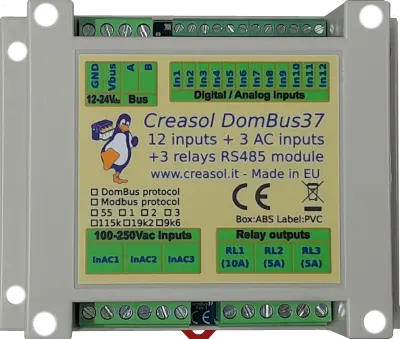 Module designed to be connected to alarm sensors (magnetc contact sensors, PIRs, tampers): it's able to monitor mains power supply (power outage / blackout) and also have 3 relays outputs.
Module designed to be connected to alarm sensors (magnetc contact sensors, PIRs, tampers): it's able to monitor mains power supply (power outage / blackout) and also have 3 relays outputs.
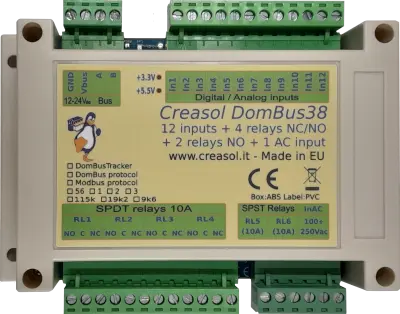 DIN rail module designed for burglar alarm system.
DIN rail module designed for burglar alarm system.
![]() DIN rail module that control azimuth + elevation/tilt motors of a sun tracker, to maximize photovoltaic energy production during the day and seasons.
DIN rail module that control azimuth + elevation/tilt motors of a sun tracker, to maximize photovoltaic energy production during the day and seasons.
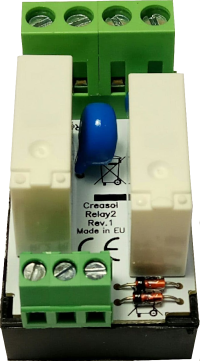 Simple module with 2 relays, to be used with DomBus modules or other electronic boards with open-collector or open-drain outputs
Simple module with 2 relays, to be used with DomBus modules or other electronic boards with open-collector or open-drain outputs
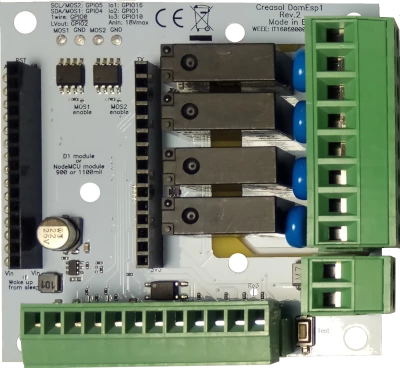 IoT board designed for NodeMCU v3 board using ESP8266 WiFi microcontroller
IoT board designed for NodeMCU v3 board using ESP8266 WiFi microcontroller
I'm using it to dimmer a LED strip with domoticz.
Just connect the power supply and led strip, and it works without expensive external dimmers.